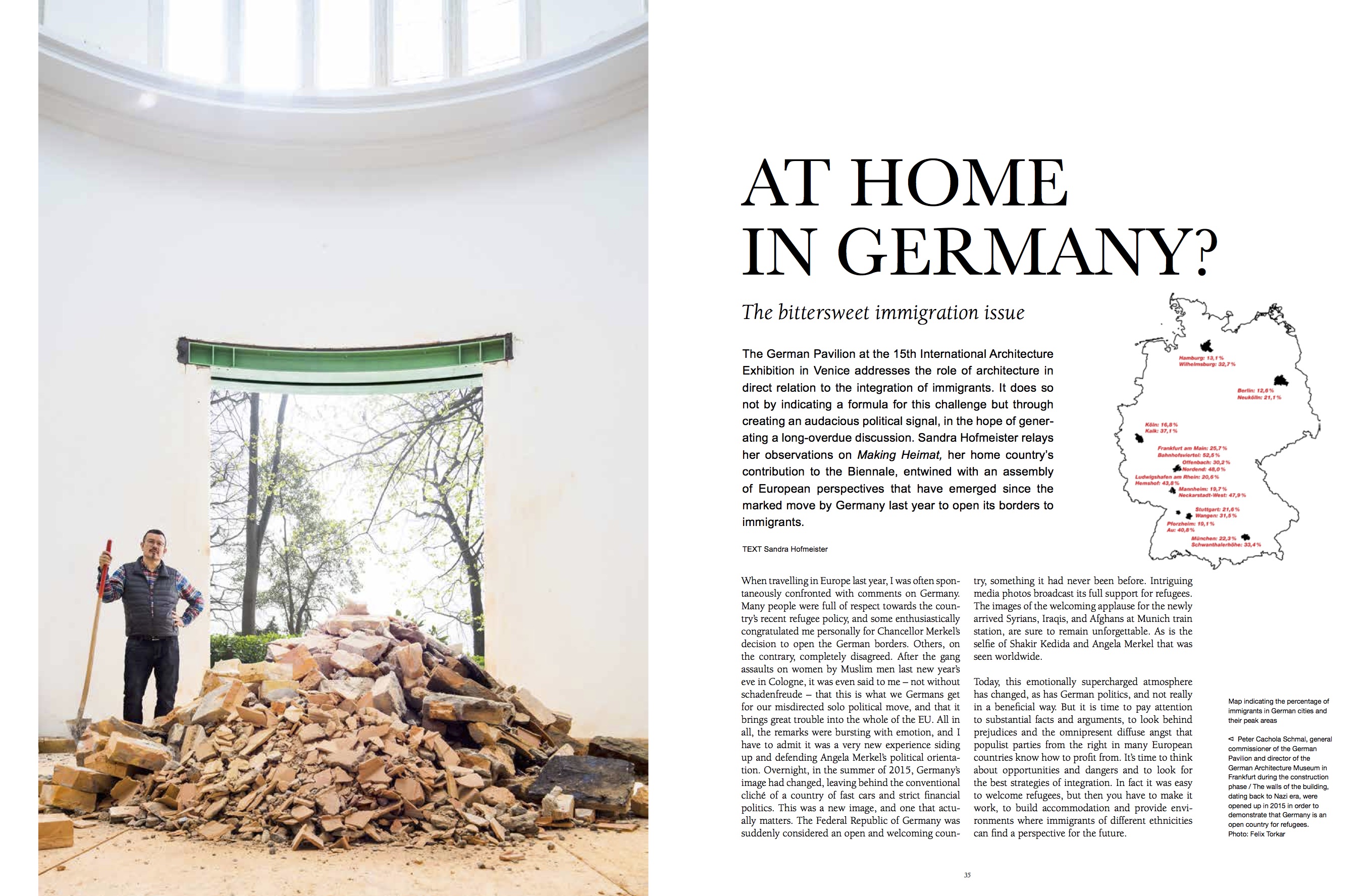A bitterweet immigration issue
The German Pavilion at the 15th International Architecture Exhibition in Venice addresses the role of architecture in direct relation to the integration of immigrants. It does so not by indicating a formula for this challenge but through creating an audacious political signal, in the hope of generating a long-overdue discussion. Sandra Hofmeister relays her observations on Making Heimat, her home country’s contribution to the Biennale, entwined with an assembly of European perspectives that have emerged since the marked move by Germany last year to open its borders to immigrants.
When travelling in Europe last year, I was often spontaneously confronted with comments on Germany. Many people were full of respect towards the country’s recent refugee policy, and some enthusiastically congratulated me personally for Chancellor Merkel’s decision to open the German borders. Others, on the contrary, completely disagreed. After the gang assaults on women by Muslim men last new year’s eve in Cologne, it was even said to me – not without schadenfreude – that this is what we Germans get for our misdirected solo political move, and that it brings great trouble into the whole of the EU. All in all, the remarks were bursting with emotion, and I have to admit it was a very new experience siding up and defending Angela Merkel’s political orientation. Overnight, in the summer of 2015, Germany’s image had changed, leaving behind the conventional cliché of a country of fast cars and strict financial politics. This was a new image, and one that actually matters. The Federal Republic of Germany was suddenly considered an open and welcoming country, something it had never been before. Intriguing media photos broadcast its full support for refugees. The images of the welcoming applause for the newly arrived Syrians, Iraqis, and Afghans at Munich train station, are sure to remain unforgettable. As is the selfie of Shakir Kedida and Angela Merkel that was seen worldwide.
Today, this emotionally supercharged atmosphere has changed, as has German politics, and not really in a beneficial way. But it is time to pay attention to substantial facts and arguments, to look behind prejudices and the omnipresent diffuse angst that populist parties from the right in many European countries know how to profit from. It’s time to think about opportunities and dangers and to look for the best strategies of integration. In fact it was easy to welcome refugees, but then you have to make it work, to build accommodation and provide environments where immigrants of different ethnicities can find a perspective for the future Then there is the second level of meaning in Making Heimat. Germany, Arrival Country. Structured into eight main arguments worked out in close collaboration with Doug Saunders, Canadian journalist and author of the book Arrival City (2010), the exhibition layout (by Berlin-based architecture office Something Fantastic) is minimalistic and consequently follows the predetermined rules of charming understatement. The pragmatic and improvised character typical of arrival cities is transferred to the design of the space: reduced posters with photographs, statistics, and short texts, printed on ordinary copy-shop paper and fixed over the corners of the walls. They visualise different arguments on the nature of arrival cities, as a city within a city, an affordable environment, or an area close to business.
Some of those observations, such as the informality of the arrival city, seem hardly to exist in Germany, except for instance the Dong Yuan Centre in Berlin, which is showcased here. Conversely, others are very much present in today’s urban environments and were set up many years ago. A series of shops in Berlin-Neuköln, for instance, where many migrants have opened their own businesses, testifies to the importance of available small-scale, ground floor spaces in creating new neighbourhoods. The exhibition floats from different arguments and pictures to figures and glances of daily life in Offenbach (near Frankfurt), the city with the largest population of immigrants in Germany. The individual case studies, documenting moments in the life of café owners, janitors, and families, are among the best photographs in the exhibition, as they draw a picture that is not at all ghetto-like but just different from other cities The third level of interpretation of this German contribution to the Biennale is the most symbolic and convincing; namely, the architecture of the Pavilion. Since its rebuilding in 1938, it has been seen as a monument serving the programme of Nazi domination – possessing a mute force, a hermetic orderliness.
In order to translate the welcoming gesture of Making Heimat into the architecture, the Pavilion has been transformed into an ‘open house’, with four large openings in its walls. Over 48 tons of brick were removed from this protected historic landmark in the process. The building will be open day and night until November, just as Germany was open last year. Visitors can use it as a resting point. From the central main entrance, there is a view of the garden through the new opening in the back wall, and simple plastic chairs can be used indoors and outdoors. This open gesture is that of an Arrival Country. It is a call to rethink Germany as a welcoming nation for immigrants. And as a metaphor for a societal departure that still has an uncertain future. We would do well to think about these kinds of transformations and the needs of our cities – in Germany and in Europe.
Text: Sandra Hofmeister

